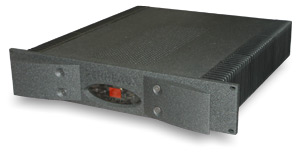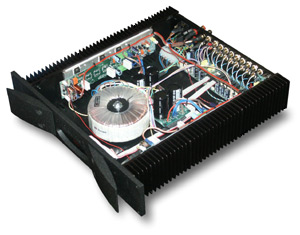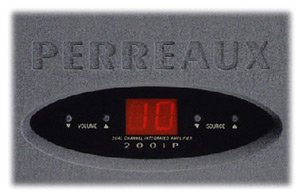![[SoundStage!]](../titles/sslogo3.gif) Home
Audio Home
Audio Equipment Review |
||||||||||||||||
August 2002 Perreaux 200iP Reference Integrated Amplifierby Doug Schneider
Perreaux has been around since 1974, but my first experience with the New Zealand-based company's products came in the mid-'80s, when Perreaux made quite a splash in North America with their well-built amplifiers and preamplifiers. The Perreaux brand name seemed like it was gaining some steam in this part of the world, and then poof, it was mysteriously gone. Although the name popped up here and there from time to time, it hasn’t attained the same exposure it did way back when -- until now. Perreaux continued producing audio equipment, but it seems that the issue that has kept their products out of the North American market in a serious way has been distribution -- a key factor for getting a brand really established on foreign soil. Audio Advisor, the large American-based online and mail-order retailer, has taken on the US distribution of the brand. This is likely the kind of clout Perreaux needs to become firmly rooted on North American soil. Description Looking through Perreaux’s website, I was impressed by how many products the company now makes. The Reference series includes a CD player, tuner, preamplifiers, power amplifiers, and this integrated amplifier. Below the Reference series is the E series of products, some of which Wes Phillips reviewed on onhifi.com. There are two subdivisions within the Reference series: Classic and P. The differences are mostly cosmetic. The Classic models have some serious style about them, with swooping, almost futuristic-looking faceplates in satin-chrome electroplate finish. Undoubtedly, some will love the appearance of the Classic faceplates, but they may be a little bit bold for others. The P series, which the 200iP is part of, still has a little bit of that swoop, but it is far more conventional in its appearance. And it’s the 200iP's formidable appearance, not the curves, that draws attention. I don’t think that you’ll find many who will object to the substantial nature of the 200iP. Overbuilt chassis are usually the domain of big-bucks separates, but not anymore. The 200iP is tough, with a massively constructed exterior. After pulling the 200iP from the box, I was impressed by how much is there. It’s the kind of integrated amp that guys gather around with their arms crossed, staring all the while and giving knowing glances that pay homage to the fact that this is a serious piece of gear. If someone said it cost $5000, no one would question the price given the fact that the market is full of inferior-looking products that cost at least that much. But the 200iP costs about half that -- $2695 USD. The review sample came in a lightly textured black finish that ended up being quite nice because it’s easy to keep clean. The heat sinks flank each side, and the front panel is 3/8"-thick aluminum with flaring handles that give the 200iP a distinctive appearance.
Perreaux rates the 200iP at 200Wpc into 8 ohms and 300Wpc into 4 ohms. In the world of integrated amplifiers, the 200iP offers a lot of power. Peak current is said to be 30 amps. Distortion, noise, and all that stuff typical of solid-state amps are negligible. Perreaux says the line and driver stages all run in class A. The MOSFET output section is a sliding A/B design, meaning it runs in class A for a small bit and then moves into class A/B as more power is needed. The chassis gets only moderately hot providing you give it adequate ventilation. For the review period, I let it sit in the open, and it was always cool enough to touch. On the back are five sets of RCA line-level inputs and one set of balanced XLR inputs. There are also heavy-duty speaker binding posts and an IEC receptacle for the power cord. I used the supplied cord, although obviously you can tweak with an after-market cord. Should you wish to use the 200iP as a preamp or power amp, there are single-ended preamplifier outputs and power amplifier inputs. This allows you to drive an external power amplifier with the 200iP’s preamplifier section; drive the 200iP’s own power amplifier with an external preamplifier (or perhaps directly from CD player that has its own volume control); or, as I did, loop out of the 200iP and into a subwoofer.
System The 200iP was used to power some very different loudspeakers. Because I was just wrapping up a review of the wee $255-per-pair Axiom Audio M2i loudspeakers, I started there. After that I moved to the hair-over-$1000 Polk Audio LSi9s. After that, I went more upscale to Verity’s floorstanding $5000-per-pair Taminos. This is just a partial list and the ones I’ll describe in this review -- there were about double this number that came through my room in the last short while. And while some amplifiers work better with one speaker than another, I was happy to find that the 200iP was more or less a gigolo among amplifiers: it seduced and mated with any speaker I threw at it. Cables were all Nirvana S-L series, and digital sources alternated between the Arcam CD23T CD player and the marvelous Zanden Audio 5000 Mk II DAC being fed by my Theta Data Basic transport. Sound The beauty of a good-sounding, high-powered integrated amp like the 200iP is the flexibility it gives you in using speakers -- both easy and difficult ones to drive. As you would expect from good modern-day solid-state amplification, the 200iP has little real character of its own. In other words, it’s neutral and offers a high level of transparency with enough oomph to ensure that your speakers are doing everything they can. And if you’ve been under-powering your speakers, you might be surprised at what’s really there when an amp like the 200iP is at the helm. As I mentioned, the first speaker I tried with the integrated amp was the smallest and, by far, least expensive -- Axiom’s new $255 M2i. Given the M2i's price, more than likely these speakers are going to get used with one of those inexpensive receivers with all kinds of bells and whistles but very little real power despite what their specifications might indicate. With some power, like that offered by the 200iP, the little Axiom speaker springs to life. The 200iP had a vice-like grip on the little M2i, making it deliver a surprisingly full sound compared to the smaller, lighter-sounding amplifiers I used it with. There’s something about having more than enough power behind the crossover and drivers that results in greater ease to the presentation. No, the 200iP didn’t make the small speaker grow to floorstanding proportions, but it helped give it a rock-solid, almost visceral sound that was surprising given the M2i’s tiny size. Bruce Springsteen’s The Ghost of Tom Joad [Columbia 67484] had a full and resonating presence. Springsteen's voice shimmered tightly between the speakers, and the instruments were well carved from the mix. As I found with this and subsequent speakers, you rarely need all the power this amp delivers. Most of the time, the amp outputs only a few watts. The rest of the power is there for those few times you may really need it, such as with orchestral climaxes at high volumes, or that really nasty speaker load that needs more "grunt." Serious power is something Polk’s LSi9 speakers like. The LSi9 is a modest-sized speaker, but it's a little brutish in terms of its power requirements, particularly in the bass. Our own measurements show a 3-ohm low-impedance point at about 50Hz, and my own single-ended Blue Circle BC2 amps aren’t appreciative of that. The 200iP didn’t even blink. The 200iP plays with a firm grip that keeps the woofers at attention. Drums and other low-frequency instruments take on increased weight and articulation, and the overall level of precision is impressive. And it isn’t just the bass range that comes to life; the midrange does too. Vocals, a strong point of the Polk speaker, had velvety richness and you-are-there immediacy. Overall, what I achieved was a very vivid, rich, and clean sonic picture, and it was proof that the 200iP didn’t just deliver power for its own sake -- it delivers clean and refined power. Of all the amplifiers I’ve used the LSi9 with -- my Blue Circle BC2s and Arcam’s FMJ A32 integrated included -- the 200iP sounded the best with this speaker, likely because of the high power. The Verity Audio Tamino also appreciated the power and control of the 200iP. The Taminos are nearly full range, but I found that their bass can be a little bit overblown if care is not taken with room placement and associated equipment. With my BC2s, I had good performance, but it was a little bit boomy from the lower midrange on down. The same was true with the LSi9s. The 200iP proved to be a great match with the Taminos, and it made for a tighter and more cohesive performance from top to bottom. The first album I played through the Taminos was Willie Nelson’s The Great Divide [Universal 586231]. I’ve heard Willie sing "Won’t Catch Me Cryin’" enough in my evaluations over the last couple of months to get truly bored of it, but the 200iP showed some flair. Depth is hard to determine on "Won’t Catch Me Cryin’" since it has an artificially produced stage, but the way the soundscape is laid out with the 200iP is solid and detailed. Nelson’s voice is precise and placed firmly in the center of the stage; the piano accompanies him with great clarity and weight. It was here that I noticed the Perreaux’s main strengths besides its power output and bass extension: it has richness and vibrancy to its sound. In hindsight, when I looked back at what I heard through the M2is and LSi9s, these were there too. The 200iP's highs are extended and clean, never harsh or edgy. And while The Great Divide doesn’t allow me to gauge the stage, I did end up playing some good recordings that did show me depth and soundstage specificity. My old favorite, the soundtrack to the movie The Mission [Virgin 90657-2], is good for determining this. Laterally, the 200iP is rock solid with highly focused images. The 200iP definitely isn’t a laid-back amplifier; it thrusts things solidly in place and a little up front. I like this because such a presentation is involving. Depth is also good, with a strong illusion of front-to-back space. Comparison Although Arcam's $2095 FMJ A32 is a little less expensive than the 200iP, I compared the two because I think that at around the $2000 mark, potential buyers are looking for a serious piece of audio equipment, and this applies to both of these integrated amps. And for more money you do get more power out of the 200iP. The A32 is rated at 100Wpc -- half as much power for 25% less money. So if you need power, look at the Perreaux 200iP. The A32 is by far more feature rich than the 200iP. It allows you to do all sorts of tweaky things like adjust each input for varying levels so that everything plays at the same loudness, alter the increments on the volume control, change the way the volume-control display shows, and on and on. The 200iP is not as sophisticated, but I certainly do wish that it had a few of the A32’s features. On the flip side, the 200iP counters with its build quality. The A32 is certainly well built and exquisitely styled, but it’s simply not as substantial a piece of equipment as the 200iP. There is a massiveness about the 200iP that the A32 just can't match. But probably the most important thing to audiophiles is (and should be) the sound. I find little variation among well-designed solid-state amplifiers like these. The feature set and power output of these integrated amps are, by far, larger differences than the sonic characters. Operating within their limits, they sound very similar, but there are some differences. The A32 has a razor-sharp, crystalline presentation -- that’s its strength. Bass is there, well-defined and deep, but the A32 isn’t a visceral-sounding integrated amp. It’s pure and exceedingly clean -- it sounds like nothing’s there. The highs have an airy sweetness about them that makes the A32 a worthy piece at the two-kilobuck price point. On the other hand, the 200iP has more thrust and impact. These are partly a power thing -- the 200iP just seems to take hold of a speaker and really hammer out those bass frequencies -- but they extend upward into the midrange too. There's the richness and vibrancy I mentioned. This A32 is certainly not lean-sounding, but it is leaner than the 200iP. The 200iP is just a bit more gutsy, more robust. Some may call it warmth, but I don’t characterize that way. It simply sounds more there, more full. Conclusion The Perreaux 200iP Reference belongs to a special group of audio products. No, the 200iP isn’t the best integrated amp you can buy, but it’s one of those products that gets you almost all of the way there for considerably less money. And what’s missing is far less significant than the amount of money you’ll have to spend to get appreciable improvement. The 200iP is refined-sounding, has loads of power, and sports awesome build quality. It’s not really rich in terms of functionality, but it mated nicely with every speaker I threw at it. Not all integrated amplifiers can boast about this. The 200iP is the kind of integrated amp that can march into your home, take its place between your speakers, and give you outstanding performance for years to come -- even if you decide to change your speakers from time to time. In the end, this makes the Perreaux 200iP Reference a remarkably versatile performer. ...Doug Schneider
|
||||||||||||||||
|
||||||||||||||||
![[SoundStage!]](../titles/sslogo3.gif) All
Contents All
ContentsCopyright © 2002 SoundStage! All Rights Reserved |

 Not surprisingly,
the 200iP is heavy, weighing in at almost 40 pounds. The dimensions make shelf placement a
bit awkward due to the unusual depth of its 19"W x 3.5"H x 18.1"D chassis.
If your shelf accommodates normal-sized equipment, the 200iP will likely hang out
the back a bit. On the other hand, if you’re the kind of person who likes to let your
amp breathe in the open for all to admire, then you will probably enjoy the extra length
and the rather shallow height.
Not surprisingly,
the 200iP is heavy, weighing in at almost 40 pounds. The dimensions make shelf placement a
bit awkward due to the unusual depth of its 19"W x 3.5"H x 18.1"D chassis.
If your shelf accommodates normal-sized equipment, the 200iP will likely hang out
the back a bit. On the other hand, if you’re the kind of person who likes to let your
amp breathe in the open for all to admire, then you will probably enjoy the extra length
and the rather shallow height.  Except for main
power and mute, the 200iP is fully operational via the lightweight universal remote
control. The 200iP is fairly easy and intuitive to use, and anybody with reasonable
remote-control experience will learn quickly. Volume level, input selection, and amplifier
status are shown on a small LED readout in the middle of the 200iP's front panel, and
small buttons in this same area allow you to change the volume and source.
Except for main
power and mute, the 200iP is fully operational via the lightweight universal remote
control. The 200iP is fairly easy and intuitive to use, and anybody with reasonable
remote-control experience will learn quickly. Volume level, input selection, and amplifier
status are shown on a small LED readout in the middle of the 200iP's front panel, and
small buttons in this same area allow you to change the volume and source.